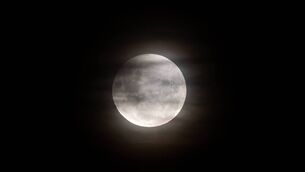Ibis is struggling for survival
Not everything is bad on the ibis front, however; significant progress is reported from a Spanish reintroduction project, supported by Dublin Zoo. This critically endangered species doesn’t visit Ireland, but the zoo’s bald ibises are among our rarest breeding birds.
The northern bald ibis (Geronticus eremita) is a big black shaggy bird with a long pink bill, curved downwards like a curlew’s. The head is bare, vulture-like. Ibises resemble waders, although herons and storks are their closest relatives. The bald species likes dry stony places, where it pokes for creepy crawlies with its forceps-like beak. The glamorous sacred ibis, gleaming white with a black head and neck, is a close relative. The ancient Egyptians mourned the departure of the life-giving sun each evening. The lunar deity Thoth offered some consolation. The ibis bill resembles a new moon, so the bird came to represent Thoth. It was mummified and placed in graves with the deceased. The bald species once bred throughout North Africa, the Middle East and Europe as far north as Germany. The Swiss naturalist Conrad Gessner depicted what he called ‘the forest raven’ in his Historia Animalium of 1555. Ibises were good to eat, he declared.
Soon after Gessner’s time, their numbers began to fall and the population has declined ever since. Hunting, habitat destruction and pesticides may be to blame. Fifty years ago, the only remaining colonies were in Morocco, Algeria and Turkey. The last Algerian one disappeared in the 1980s.
A local belief that Noah released a bald ibis, not a raven, helped protect the Birecik colony in Turkey. It did not, alas, prevent its ultimate demise.
In 2002, three ibis pairs were discovered breeding in Syria. For the last two seasons, there was just one nest, but this year only a single bird was present. Its mate’s satellite tag ceased transmitting last July. Only the Moroccan colonies remain. There are about 100 breeding pairs at the Souss-Massa National Park, where climbers have created extra ledges to encourage pairs to nest.
Dublin Zoo sponsors satellite tracking as part of the international bald ibis conservation project. In 2002, a cliff with breeding ledges was created at the zoo. Twelve ibises were brought from Twycross in Britain. The first Irish hatched chicks were raised in 2006. There are three nests this summer. However, attempts to reintroduce birds to the wild during the 1970s and 80s had little success. In 2003, El Proyecto Eremita was established with the help of the Ministry of the Environment in Andalusia. ‘Eremita’, meaning ‘hermit’, is the species name of the bald ibis. Aviaries were established at two sites owned by the Spanish army. Fledged birds are allowed to fly freely and over 70 released birds are now living wild. In 2008, a free-flying pair laid eggs.
According to a report in Wildlife News Extra, 37 Spanish and French-bred birds were released in three batches last year. Ten pairs nested on a cliff 15km from the release site. Four of the nests were attacked by rats, causing the parents to desert. Chicks at two other ones became infested with mites.
While the bald ibis is by no means ‘out of the wood’, the developments Spain are encouraging.













